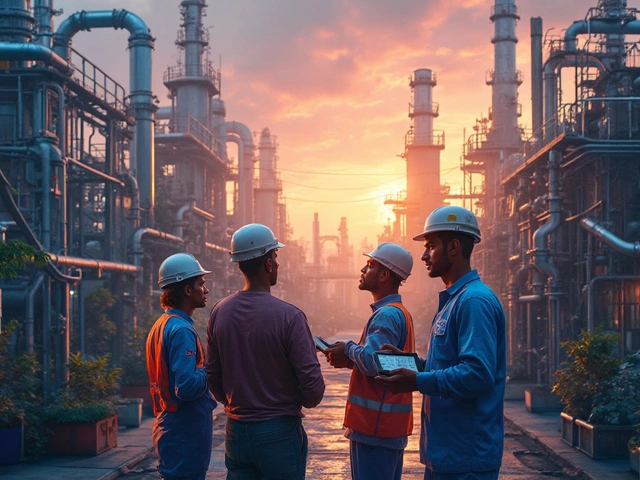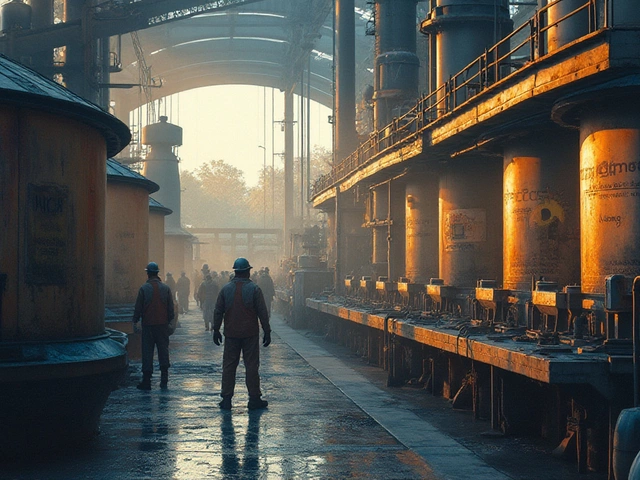India's chemical industry plays a pivotal role in the global economic landscape, ranking as one of the fastest-growing markets. With its vast expanse of diverse applications ranging from pharmaceuticals to textiles, the industry continues to attract considerable attention. Chemicals not only power the nation's industrial backbone but are also integral to daily life.
A deep dive into the substances predominantly demanded in India reveals interesting narratives of both traditional practices and modern innovations. Understanding these patterns is vital for stakeholders across various sectors. The demand for chemicals often reflects the underlying economic activities and cultural inclinations present in the region.
From fertilizers that bolster the vast agricultural realms to industrial solvents essential for manufacturing, India’s chemical landscape is remarkably varied. In grasping the key chemicals that lead the charge, we embrace both the staples that have stood the test of time and those that herald new beginnings endorsed by technology and consumer needs.
- Introduction to India's Chemical Industry
- Most Commonly Used Chemicals in India
- Factors Influencing Chemical Usage
- Future Trends in Chemical Manufacturing
Introduction to India's Chemical Industry
The chemical industry in India is a behemoth standing as the six-largest globally and third in Asia, a testimony to the nation’s ever-growing industrial competency. It's an engine of innovation and economic growth, contributing to nearly 7% of India’s GDP. The industry is diverse, covering a wide range of products like petrochemicals, fertilizers, pharmaceuticals, paints and coatings. It supports critical sectors such as agriculture, automotive, construction, and consumer goods, positioning itself as indispensable to the nation’s economic fabric.
Historically, the Indian chemical landscape has evolved from small-scale indigenous crafts to an organized sector replete with state-of-the-art research facilities and advanced technology. The period post-liberalization saw an influx of foreign investments and collaborations, transforming Indian manufacturers into competitive players on the global stage. A robust regulatory framework and government initiatives like the ‘Make in India’ campaign have bolstered confidence in the chemical sector, stimulating both domestic and export-oriented production.
One fascinating aspect of India's chemical sector is its dual nature of being both capital-intensive and labor-intensive, providing livelihoods to millions across the nation while demanding high-quality technological advancements. The rise of Special Chemical and Petrochemical Investment Regions (PCPIRs) marks a strategic effort to create world-class infrastructure, integrating production, research and development facilities while minimizing environmental impacts. The chemical industry also contributes significantly to the nation’s foreign exchange earnings, with chemicals and related products forming a considerable part of India’s exports.
Despite these achievements, challenges such as stringent environmental regulations, sustainability concerns, and competitive pressures from other emerging markets pose hurdles. Innovation and adaptation are key as the sector navigates shifts in global trade policies and market demands. A balance between growth and ecological sustainability remains a constant focus, driving a new wave of research into green chemistry and sustainable practices. As noted by a recent report from the Federation of Indian Chambers of Commerce and Industry (FICCI), "The Indian chemical industry stands at the cusp of a tremendous opportunity, with the potential to reach USD 304 billion by 2025."
The future of the industry is also closely tied to technological integration and digitization, as companies embrace Industry 4.0 technologies such as the Internet of Things (IoT), advanced analytics, and Artificial Intelligence (AI) to enhance operational efficiency, safety, and productivity. Collaborations with start-ups in the fields of biotech and nanotech further propel the sector towards novel solutions and markets.
In the pursuit of a global leadership position, Indian chemical manufacturers are re-engineering traditional processes, investing in new capabilities, and exploring synergies across value chains. As the sector lays out its plans for sustainable growth, the commitment to innovation and environmental stewardship will undoubtedly influence its trajectory, ensuring that India remains at the forefront of the global chemical frontier.

Most Commonly Used Chemicals in India
India's chemical industry is a vibrant and diverse sector, with a wide range of substances utilized across various industries. Among the chemicals that see extensive use, a few stand out due to their enormous demand and significance. One of the most noteworthy is sulfuric acid, often referred to as the 'King of Chemicals'. It is indispensable in the production of fertilizers, particularly phosphates, given India's vast agricultural landscape which heavily relies on such inputs to enhance productivity and support its agrarian economy.
Another crucial chemical is ethylene, often considered the warehouse of organic chemistry. Ethylene serves as a building block for a multitude of products, ranging from plastics, such as polyethylene, which is ubiquitous in packaging, to ethylene glycol, used in antifreeze formulations. The Indian manufacturing sector leverages ethylene extensively, underscoring its central role in both industrial and consumer applications. A study highlighted that nearly 60% of ethylene produced globally finds its way into polyethylene production, reflecting its immense utility and demand.
The bleach industry, which sustains both domestic and industrial needs, utilizes sodium hypochlorite extensively. This particular chemical is pivotal for water treatment plants across India, ensuring safe and clean water supply. The significance of sodium hypochlorite extends into sanitation and hygiene sectors, which have gained heightened prominence in recent years. Likewise, caustic soda, or sodium hydroxide, is another chemical heavily used in the country. Essential for paper manufacturing, soap production, and a plethora of cleaning agents, it symbolizes a cornerstone of India's expansive manufacturing capabilities.
India's textile sector, known globally for its quality and variety, relies heavily on acetic acid and its derivatives. These chemicals are critical for the dyeing process, ensuring vibrant and long-lasting colors in fabrics. Acetic acid finds further applications in the food industry as a preservation agent, reflecting its versatility. The value of such chemicals is underscored by the Indian Chemical Council's reports which frequently affirm their indispensable nature in everyday economic activities.
"The chemical industry is the backbone of industrial and agricultural development, driving growth in both traditional and emerging sectors," an observation frequently noted in industry analyses.
A more household-name chemical, urea, is another high-demand product, primarily due to its role as a nitrogen-release fertilizer. Indian agriculture, being the primary economic activity for a sizeable portion of the population, depends on urea for enhancing soil fertility and agricultural output. The demand for urea has consistently catalyzed investments into domestic production facilities, aiming to meet the country's substantial requirements and reduce reliance on imports. This strategic focus on urea production exemplifies an overarching trend toward self-sufficiency in key agricultural inputs.

Factors Influencing Chemical Usage
Understanding what drives the demand for chemicals in India requires a multifaceted approach, incorporating perspectives from economic trends, cultural practices, and technological advancements. The sheer size of the Indian market, with its vast population and diversity of industries, inherently creates a large and varied demand for chemical production. One significant factor is agriculture, a sector where chemicals such as fertilizers and pesticides are indispensable. With nearly half of India's workforce engaged in agriculture, the need for these chemicals to increase yield and ward off pests cannot be overstated.
Moreover, the rapid industrialization and economic development of India contribute significantly to the demand for various chemicals used in manufacturing processes. Industries such as textiles, pharmaceuticals, and rubber heavily depend on specialty chemicals for production. Chemical manufacturers in India must adapt to the growing need for high-quality chemicals while striving to maintain competitive pricing. This drives both innovation within the sector and the adoption of advanced technologies.
"The growth of India's chemical industry is a reflection of broader economic trends, particularly those linked to urbanization and rising standards of living," says Dr. Ramesh Kapur, a leading economist in industrial studies.
Environmental considerations and regulatory frameworks also play a crucial role. Increasingly stringent environmental regulations push manufacturers towards greener and more sustainable chemical processes. This shift affects both the supply chain and the end use of chemicals, influencing what is produced and how it is utilized across different sectors. Here, green chemistry is not just a trend but a necessary shift, responding to both international pressure and local environmental needs.
The market's response to technological innovation is another driver that cannot be overlooked. There's a rising demand for more efficient and less harmful chemicals, spurred by advances in technology and the rise of smarter production techniques. As India moves more towards digital integration, even traditional sectors such as agriculture and textiles are embracing smart technologies that enhance the use and application of chemicals. These evolving patterns reveal a clear emphasis on aligning chemical usage with sustainable development goals.
Demographics also exert influence, with India's youthful population and growing middle class driving consumption patterns that demand improved lifestyles and products. This, in turn, influences the range of chemicals required, from personal care products to household goods. Such demographic shifts ensure a dynamic market, constantly challenging chemical manufacturers to innovate and expand their portfolios. Ultimately, chemical demand in India is a tapestry woven from economic growth, environmental responsibility, technological advancement, and evolving consumer needs.

Future Trends in Chemical Manufacturing
As the global landscape shifts towards more sustainable and innovative solutions, the chemical industry in India is poised for transformative changes. One of the most noticeable trends is the pivot towards green chemistry. This approach focuses on reducing the environmental impact of chemical processes and products. By using sustainable feedstocks and reducing waste, Indian manufacturers are embracing eco-friendly innovations as part of their core business strategy. This movement not only caters to global environmental standards but also enhances the marketability of their products.
The integration of digital technologies is another key trend reshaping the chemical production process in India. Industry 4.0, characterized by the fusion of the physical and digital worlds, is enabling manufacturers to utilize advanced analytics, AI, and IoT systems. These technologies help optimize production processes, improve efficiency, and reduce costs. For instance, real-time monitoring can enhance the predictive maintenance of machinery, reducing downtime and ensuring smoother operations. A report by McKinsey suggests that the full implementation of digital technologies could reduce operating costs in the chemical sector by up to 30%.
"The adoption of digital solutions is not just an option but a necessity for the future competitiveness of chemical manufacturers," a leading industry expert notes.
Moreover, there's a noticeable shift towards localized supply chains. Learning from disruptions such as those experienced during the COVID-19 pandemic, Indian chemical manufacturers are exploring ways to source raw materials closer to their production facilities. This trend not only secures the supply chain against global volatilities but also supports the domestic economy. Initiatives like 'Aatmanirbhar Bharat' (Self-reliant India) underscore the importance of strengthening local manufacturing capabilities and reducing dependency on imports.
The burgeoning demand for specialty chemicals in sectors like pharmaceuticals, agrochemicals, and textiles is also an important trend shaping the future. These specialty chemicals are characterized by their specific focus and application, offering higher value and better margins compared to traditional chemical products. Innovations in this area are being driven by the need for more effective solutions in agriculture and medicine, positioning India as a hub for chemical creativity and application.
Lastly, government policies and regulations are playing a crucial role in steering the direction of chemical manufacturing. Stricter regulations concerning pollution and safety standards are encouraging companies to invest in cleaner technologies. The government is also introducing incentives for research and development, promoting new innovations that can compete on the global stage. As these trends continue to evolve, Indian manufacturers are at the forefront, adapting swiftly to the demands of an ever-changing market while maintaining their competitive edge.





Write a comment